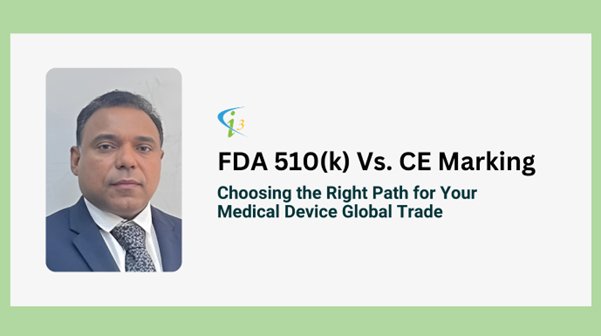FDA 510(k) Vs. CE Marking: Choosing the Right Path for Your Medical Devices Global Trade

The global medical devices industry is a dynamic and rapidly evolving sector, driven by advancements in technology, increasing healthcare demands, and regulatory requirements. Medical device manufacturers face complex challenges as they navigate diverse markets with different regulatory requirements and standards, including FDA 510(k) submissions in the U.S. and CE marking in Europe and partially accepted to the UK. With a growing focus on innovation and patient-centric solutions, the global medical device trade continues to expand, offering opportunities for manufacturers to enter new markets, improve patient outcomes, and drive industry growth.
The CE Marking and FDA 510(k) processes can be challenging, but they vary in complexity depending on factors like the device type, its classification, and the quality of the supporting documentation.
EU MDR and IVDR CE Marking
The European Union MDR (2017/745) and IVDR (2017/746) are considered more rigorous than the previous MDD and IVD Directives due to stricter safety and performance requirements, increased scrutiny, and more extensive clinical data demands. Manufacturers need to comply with General Safety and Performance Requirements (GSPRs), provide detailed risk management documentation, and demonstrate the safety and efficacy of their devices through clinical evaluations or equivalence. Notified Bodies now have a more active role, and the complexity of the submission increases with device classification (e.g., Class III or Class D devices require more extensive technical documentation). The new clinical evaluation and performance evaluation, and post-market surveillance (PMS) systems make ongoing compliance tougher.
US FDA 510(k)
The FDA 510(k) pathway is generally faster and more cost-effective compared to the more intensive Premarket Approval (PMA) process. However, it still presents challenges. A 510(k) submission requires demonstrating that a device is substantially equivalent (SE) to a legally marketed predicate device. The process can become complex depending on the device type and changes from previous models, especially when new technologies, materials, or software are involved. The FDA’s expectations for clear documentation make the 510k process tough for manufacturers. The eSTAR system is helping to streamline the process, but it still requires thorough preparation.
A Comparison of Global Acceptance
Global acceptance of CE marking and FDA 510(k) depends on the regions and markets a manufacturer intends to target. Each pathway holds significant value in its respective regions and countries.
CE marking is required for medical devices and In-vitro medical devices sold in the European Union and other countries that recognize EU regulations, making it essential for market entry in these regions. It is also accepted in several other markets outside the EU, such as in the United Kingdom parts of Asia and Latin America, as many countries align with or reference EU standards. This broad acceptance is one of the main advantages of CE marking, especially in countries where CE marks are viewed as a benchmark quality.
The FDA 510k is primarily relevant to the U.S. market. It is one of the most recognized and trusted regulatory pathways for medical devices globally, and 510k clearance can often facilitate easier market entry into certain countries, especially those that align with U.S. regulatory practices or have trade agreements with the U.S. However, its acceptance is primarily limited to the U.S., and while some countries may accept 510k cleared devices with minimal additional regulatory requirements, many still require separate approvals, such as CE marking for the EU.
- CE Marking holds broader acceptance globally, particularly in Europe, Asia, and many other countries.
- FDA 510(k) is widely respected and facilitates access to the U.S. market, but its global acceptance is not as universal as CE marking.
In conclusion, CE marking generally offers more extensive global acceptance due to its recognition in many countries, while FDA 510(k) is crucial primarily for the U.S. market, with limited direct recognition outside it. Manufacturers targeting a broader international market may need both CE marking and FDA clearance, depending on their regions of interest.
Medical Device 510(k) and CE Marking: obstacles during design changes
Design modifications to medical devices often trigger regulatory requirements under the FDA 510(k) pathway and EU MDR.
- For 510(k), a new submission is necessary if changes significantly affect safety or effectiveness, such as labelling updates.
- Under EU MDR and IVDR, any significant changes to the intended purpose, design or performance specifications, materials, sterilization methods, packaging, or software must be reported to the Notified Body. These changes can trigger re-audits of the manufacturer’s Quality Management System (QMS) or technical documentation.
Regulatory Expert opinion
Soio George, a 510(k) and CE Marking expert from I3CGLOBAL, has supported hundreds of domestic and international companies in achieving regulatory compliance. A well-crafted regulatory strategy is essential to ensuring alignment with both 510(k) and CE Marking requirements, effectively reducing delays and mitigating risks during the approval process. While the 510(k) and CE Marking processes operate under distinct regulatory frameworks, ISO 13485:2016 serves as a universal foundation. With the introduction of the FDA QMSR, adopting an integrated Quality Management System can simplify compliance for manufacturers. Core design, performance, clinical, and risk management documentation remain pivotal for successful submissions.
Dual Strategy: Is It Feasible?
Medical device manufacturers often pursue both pathways to maximize market access. However, this demands robust regulatory planning, sufficient resources and a huge budget. Consulting with regulatory experts like I3CGLOBAL ensures streamlined processes and compliance with both FDA and MDR or IVDR regulations.
Conclusion
Choosing between FDA 510(k) and CE Marking or pursuing both requires a thorough understanding of the overall budget, risk of rejection, in-house technical expertise, availability of U.S. agents and European Authorized Representatives, regulatory requirements, device classification, and market goals. With proper guidance from an experienced consulting firm, manufacturers can strategically position their devices for global success